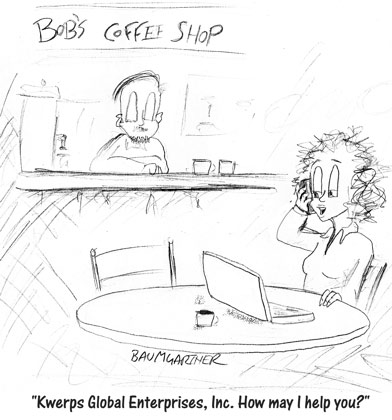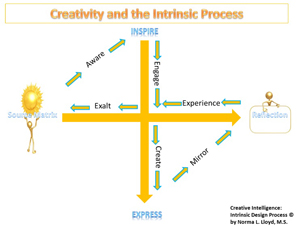By Jeff Baumgartner

In order to succeed in business, the entrepreneur needs to be creative -- not merely in terms of coming up with a potentially innovative business idea, but to keep her business going through good times and bad. Entrepreneurship, you see, is an ongoing creative challenge in which the initial idea is a relatively trivial thing. Indeed, venture capitalists and other serious investors tend to be more interested in the entrepreneurs than their ideas. Investors only want to put their money behind people who have the creative wherewithal to turn ideas into reality, ideally a profitable reality.
Here are a few creative challenges the entrepreneur regularly faces.
The Business Idea
An original business idea may not be the most important act of creativity for an entrepreneur, but an ideas is nevertheless necessary for starting a business -- with a few exceptions. Many entrepreneurs establish restaurants, shops and other traditional businesses based on providing a well established, quality product or service. In most cases, such entrepreneurs do not expect to build growing global business empires. they just want to run successful businesses that provide a decent income. Serious entrepreneurs call such people small business owners rather than entrepreneurs.
Some entrepreneurs acquire ideas for businesses from elsewhere. Microsoft became a global company when it signed a deal with IBM to provide an operating system for IBM's nascent personal computers (the grandparent of the device you are probably reading this on). However, Microsoft bought DOS (the operating system that became the standard for the first generation of PCs) and the intellectual property rights associated with it, from Seattle Computer Products, for just $50,000 in 1980; and promptly licensed it to IBM with an open contract that allowed them to market DOS to other computer manufacturers. It was this deal that eventually turned Bill Gates into a billionaire and Microsoft into one of the world's biggest companies.
Interestingly, many of the most successful entrepreneurs do not launch a radically new product so much as a significantly improved product. Search engines had been around for years when Google came out, but Google's search engine did something that Lycos, Altavista, Excite and other search engines of the early to mid 90s failed to do: it delivered with relevant search results! Friendster, Classmate and Myspace provided social networking sites before Facebook came along. But Facebook somehow managed to connect people better than its predecessors did. Perhaps first movers identify a market and customer desires that enable innovative second movers to barge in and steal the market. But that's just a guess on my part.
Money - or Lack Thereof
Among non-entrepreneurs, there is this idea that they typical entrepreneur gets funding by the sack full from venture capitalists with more money than they know what to do with. The truth is, less than one percent of start-ups in the USA get venture capital funding. If anything, even fewer start-ups outside the USA get venture funding. Other start-ups get funding from angel investors (wealthy individuals who invest money in promising start-ups), but that accounts for less than 16% of US startups (same source as above link); and a few start-ups attract crowd-sourced funding through platforms such as Kickstarter. Nevertheless, more than 80% of all start-ups in the US are reliant on the entrepreneurs' financial resources which typically include personal savings, family loans and small investments from friends.
What this means is the typical start up has limited funding and faces a continuous battle, particularly in early years, to maintain positive cashflow. The entrepreneur cannot buy her way out of trouble, so she has to use creative thinking to solve problems. When something needs to be done, but there is no money with which to do it, the entrepreneur needs to use her creative resources to work out how to do it.
Grabbing Opportunities
Small companies have a lot of flexibility. As a result, if the entrepreneur-founder identifies a relevant opportunity, she can exploit it and modify her business as necessary. Identifying opportunities and visualising how to exploit them is critical to the entrepreneur's success. However, entrepreneurs also need to be careful here. In my experience, many are too quick to see opportunities and over-diversify. Small businesses which do too many different things often fail to do any of them well. Worse, they find it harder to establish a reputation in a particular field, something that is critical to small business success.
I was running a small marketing communications company in Bangkok in the early 1990s. In 1994, I became interested in the Internet. Although it was very new as a commercial entity in those days, I felt it had great potential. I was also intrigued by multimedia -- a related technology. However to offer these services to clients on top of services my company was already offering would not be possible. I only had a team of eight people!
I thought about it some time. I could continue to run a small marketing communications business that delivered quality service, but was one of many in Bangkok. Or, I could launch one of the country's first Internet and multimedia development companies and aim to build a distinct reputation for my company in this new field. The latter option seemed more romantic, but it was also more risky. Would Thai businesses buy into new media (as the Internet and multimedia were then collectively called)?
Nevertheless, I made the decision to phase out the traditional marketing communications (print advertising, brochures, catalogues, sales kits, etc) and focus on new media. As a result, my company became established as a pioneer in new media in Bangkok. It was a good decision. But it could have wrecked my company if it had not worked. An established, large advertising agency could not have made such a move. A small, entrepreneurial company could.
Continuous Innovation
If an entrepreneur succeeds with an innovative new product, she can be sure that other entrepreneurs as well as established companies will promptly build and launch competing products. Usually, those products will be better than hers in some way. As a result, the entrepreneur can never sit still. If her creative idea succeeds as a product, she will need to use creativity to innovate her product on a continuous basis. Sometimes, she may even need to redesign or rethink her product.
The concepts behind companies like Airbnb (which allows people to rent their guestrooms and homes to travellers) and Uber (which connects people who need rides with drivers willing to drive people for a fee) are relatively simple. As they have succeeded, people have launched similar companies, most of which are probably better than Airbnb or Uber on some level. As a result, Airbnb and Uber need to innovate to stay ahead of the competitors. If they do not, they will promptly lose marketshare to the new upstarts.
Handling People Problems with Compassion
Many of my most interesting interactions with people over the years have involved my employees. In the days when I employed people (now, I work alone), I had to deal with alcoholics, emotionally unstable people, bullying, a woman whose mother was dying of cancer and a young man who disappeared (it turned out he was imprisoned for statutory rape). I even had to deal with a ghost sighting in one of the offices! I've had people crying on my shoulder and cursing me -- though never at the same time. I reassured a woman in tears from bullying and whom I felt I should hug in a culture (Thailand) where to do so would have been very inappropriate. Some of these people were great employees. The bully was very competent at her job, but bullying is not something I tolerate.
Dealing with these problems, supporting great people in difficult times, balancing the needs of those people against the needs of the company all require creativity and sensitivity. Moreover, in a small business, quality employees are critical to success while incompetent employees are at best a drain on a very limited budget and at worst a potential disaster. A bad employee can seriously damage the reputation of a small firm or ruin a business relationship with a key supplier.
Dealing with bad employees -- which usually means dismissing them -- is a difficult thing to do; it requires being firm, but compassionate. Repairing the damage caused by an incompetent employee often requires creative thinking.
Very often, the entrepreneur needs to be able to deal with people problems on the spot. When one of your best employees is in tears because her mother has been diagnosed with cancer, you do not have time to Google how to respond to employees facing tragedy. You need to think and respond, not as a friend (because no matter what you think, your employees do not see you as a friend), but as a compassionate and caring employer. You need to be sympathetic, but not push too far. You also need to keep your firm going, when one of your best employees is not at her best. If you only have yourself and three employees and one of them is not doing well, that means 25% of your workforce is not doing well.
In addition to employees, the entrepreneur needs to interact with suppliers, often also small businesses, and customer. Even when customers or suppliers are large organisations, the entrepreneur is often dealing with a specific individual. Good relationships with suppliers can lead to better services and better prices. A good relationship with the CFO's secretary (for example) can help ensure the entrepreneur can get a phone call through to the CFO.
When Things Go Wrong
When things go wrong, and they will, the entrepreneur often has no one she can turn to. She must step in and solve problems herself. Often, there are not simple solutions. Sometimes there are simple solutions, but they could be more damaging than doing nothing. The ability to see a situation in detail, identify the options and visualise which option is the best -- or which option will be least damaging -- requires creativity.
It's a Life Sentence
It seems that being an entrepreneur is a handicap as far as most businesses are concerned. Research has shown that not only are established businesses less likely to hire entrepreneurs than other people, but when they do hire entrepreneurs, they pay them less than others in similar positions. Since many job adverts indicate that the employer is looking for "entrepreneurial self-starters", this is particularly ironic. But, it seems companies are keener to hire people who call themselves entrepreneurial rather than actual entrepreneurs.
Once you become an entrepreneur, it is pretty much a decision for life. If you decide to sell your business or your business goes bankrupt, you will find it difficult to find employment in another company. This means that if one business does not succeed or if you get bored with a business as it matures, you need to use your creativity to devise and launch new businesses from time to time. And you will need to use your creative skills to try to keep those businesses afloat and, ideally, make them profitable.
That said, in my experience, entrepreneurs are different to others. They are driven, continually creative and enjoy challenges that frighten many others. Frankly, most entrepreneurs prefer not to be employed, but to employ.
-Jeffrey Paul Baumgartner (hence the JPB in jpb.com). I am considered something of an expert in creativity and innovation. - See more at: http://www.jpb.com/index.php#sthash.9SOeTbu9.dpuf
By Norma L. Lloyd, M.S.
Creative Intelligence: A Natural Intrinsic Design by Norma L. Lloyd, M.S.
There is an innate power in creativity, a source of creative intelligence (CQ) that drives the passion of inspiration forward, engaging those that touch into that source to expand an emerging and evolutionary future into existence. This intrinsic level of creativity is a natural source of inspiration, an intricate design process known to many innovators and artists who are empowered, engaged and who emerge from their reservoir with an abundance of creative outcomes. Creative Intelligence implies a resource of consciousness that can be accessed deep within ourselves, insights from "inside the box" of identifiable characteristics and traits that we believe makes up who we are. Join me in this conversation about creative intelligence and explore several “keys” that I have shared in this article for you to tap into your unlimited intrinsic wellspring of creative potentials.
When we think of highly creative individuals who have greatly impacted our society, perhaps changed the way in which we live and left their mark on history, we think of people like Alexander Graham Bell, Nikola Tesla, Marie Curie, and of course technological gurus like Steve Jobs. Most people see these individuals as having unique special talent and perhaps as being a genius in delivering those unique gifts.
My personal journey as an artist and my investigations into creative potentials has opened understandings as to what possibly lies beneath some of those creative outcomes. These wondrous examples in our history demonstrate a high level of intrinsic creativity and a partnership with source. They also share a common theme of sensory methodologies in accessing their insights. Creative Intelligence, as a source of inspiration, is common to all of us, a natural design that calls forward creative genius and evolutionary outcomes. The important question is: are we listening?
Consider for a moment that everyone has that level of intrinsic creative potential, a circle of inspired communication, a source of Creative Intelligence (CQ) that surrounds them. This source reveals itself in sensory ways such as innovative thoughts, visualizations, insightful dreams and reflective experiences and understandings. These sensory insights provide a look into the depth of creative intelligent design that makes up human individual consciousness. I believe that we all have access to this level of creative potential. Some individuals may have run the four minute mile and crossed the finish line on creative potentials, but we are all in the race!
Creative Intelligence is an inspired complex system of communication, an innate language that speaks though every individual, group and societal expression. In my personal experience, CQ is a self-communication system and this system is always on. It resonates with my environment, shifts with my thoughts and actions and provides the most amazing guidance as to best potentials to engage with on my journey of evolution. The design graph shown below demonstrates a sample of the multiple steps in the creative intrinsic design process. As you can see, there are several key choices that individuals can make in taking an inspired concept into fruition, but the first step is awareness.
Note. From Lloyd, Norma, 2014, The Nature of Creative Intelligence,
Retrieved from, http://www.centerforcreativeintelligence.org/services.html
As an intrinsic creative process CQ is a spontaneous experience, a presence and an allowing of creative potential to come forward. This sensory information tends to emerge with unknown unique patterns, evoking intuitive attraction, calling for expression and reflecting in return a great personal fulfillment. CQ as a completed process can be a powerful self-realized state of creative excellence and is frequently accompanied by exaltation! Nikola Tesla, a genius in CQ communication through visualization, stated, "I do not think there is any thrill that can go through the human heart like that felt by the inventor as he sees some creation of the brain unfolding to success. Such emotions make a man forget food, sleep, friends, love, everything." (O'Shei, 2008, p.5)
People with high levels of creative intelligence are exceptional in utilizing sensory tools such as visualization, dreams, walks in nature, music and surround themselves with a creatively empowered environment to supercharge their potentials! Being highly creatively intelligent may involve extremes, such as Sir Dr. NakaMats, who patented the floppy disk in 1952 and has patented more than 3,300 inventions total during his 74 years of life. His creative secret: many of his greatest ideas hit him when he was close to drowning. “To starve the brain of oxygen,” says the man, "you must dive deep and allow the water pressure to deprive the brain of blood. Zero-point-five seconds before death, I visualize an invention." The Japanese inventor then jots his idea down on an underwater notepad and swims back to the surface. (Steffani, 2014) Or perhaps, a more simple approach like British Playwright W. Somerset Maugham, who had to face a blank wall before the words would come (any other view, he felt, was too distracting). (Currey, 2013)
As an important part of the educational learning experience in creativity, we have inspirational stories in each academic field, those who have revolutionized the way things are accomplished and who have demonstrated exceptional skills and talents. These established pathways weave in and out of each discipline across the academic system. Each field has their own, predominantly extrinsic process, a predetermined pattern for performing as a creative individual. Our changes in technology alone and business leaders such as Steve Jobs, powerfully demonstrate the creative nature of the human species and the realization of those potentials in business success. We as a society certainly value the outcome that creativity has to offer, but why then do we not see more creative genius talent present in our organizations? Are we providing environments that enhance creative intelligence in the workplace?
Our creative challenge today is to set aside the patterns of what we know about the creative process and seek understanding on the commonalities of individuals, corporations and specialized fields that exhibit the highest degree of intrinsic creativity. We would benefit by elevating the dance of awareness, the recognition of innate inspired potentials and the engagement of an environment that encourages greater access. Creative Intelligence is an intrinsic design process that requires recognition, identity and value. There is a necessity for expanded heart and "gut feeling" type education in the creative process. We have so much more scientific information today on the significance of emotional and sensory attributes and the impact they have on physiological balance in the heart and brain. We have immense possibilities of creative potentials to gain by investing in an environment that fosters both aspects of creativity.
According to Peter Seidler, a recognized author in Business Week and HR Matters, "If we start with the assumption that we are intrinsically creative and have access to great internal resources, then it follows that the only real difference between these two states – ordinary mind and an actualized creative state - is that in the actualized state we have complete confidence in our intrinsic creativity and resourcefulness. Think of the power in that!" (Seidler, 2011)
The CQ Journey
As a Business and Clinical professional my application of creativity had always been well recognized. When I began to create as an artist though, my insights into creative intelligence and the depth of spontaneous access to potentials greatly expanded. Not only was each visual art piece a gifted surprise, but the tapestry of circumstances that brought it about created a personal transformational experience. The revelation on how the images evoked emotion on others provided great inspiration as well. Creative Intelligence is a fluid journey, an evolution of source in partnership with self. Accessing Creative Intelligence involves taking an introspective journey, engaging in a dance of awareness and being flexible about establishing a partnership with one’s own nature of creative reality.
While I am sure there are many roads that lead to the promised land of creative potentials, there are several key factors that I have learned that are really simplistic and that can accelerate the process. First, the pathway is one that is lined with good thoughts, especially about unknown potentials and possibilities of success. Leave your expectations and habitual thinking outside the door. You can always pick it back up when you are finished. Second, emotions are very significant in creating an imaginal environment that can dance with flirtations from the universe. Pretend to play and get in the mood. Third, be grateful and appreciate for all you have. Visualize a loved one, a beautiful sunrise or a happy memory. The gateway to creative intelligence is child-like, reflecting joys of self-realization!
 When viewing my abstract art images, the most common question people ask me is, "How do you create this?" The truth is I am in partnership with my source of inspired expression, and each step of the creative process is unknown, yet seems to flow effortlessly into place. Each resulting image is a surprise and emerges with excitement. They are birthed because I am willing to be in the spectacular dance of creative intelligence. This ability to be in expression of CQ has an electrical charge. I sense a connection, and it feels exciting, attracting my attention. The resulting image provides an amazing reflection of self-fulfillment in its realization. This art image is called, "Journey Home". When I ask people what they see in the image they typically describe a connection to spirituality and peace and a feeling of harmony. CQ in my experience is a self-partnership with that aspect of emotional balance.
When viewing my abstract art images, the most common question people ask me is, "How do you create this?" The truth is I am in partnership with my source of inspired expression, and each step of the creative process is unknown, yet seems to flow effortlessly into place. Each resulting image is a surprise and emerges with excitement. They are birthed because I am willing to be in the spectacular dance of creative intelligence. This ability to be in expression of CQ has an electrical charge. I sense a connection, and it feels exciting, attracting my attention. The resulting image provides an amazing reflection of self-fulfillment in its realization. This art image is called, "Journey Home". When I ask people what they see in the image they typically describe a connection to spirituality and peace and a feeling of harmony. CQ in my experience is a self-partnership with that aspect of emotional balance.
Excellence in leadership and organizational learning means incorporating an environment and culture that fosters intrinsic creativity. Several supportive scientific studies are emerging that help to define and broaden our perceptions and importance of emotions in leadership in designing intelligent conversations with employees that foster creativity. So, as we move forward, let’s create a new stage, perhaps an improvisational theatre, where just for few moments in time the boundaries of old patterns and habits can be set aside and we can create something, an awesome unexpected potential from a totally unknown place. It just might be the creatively intelligent thing to do!
Keys to Accessing CQ
Below are several methods from my course workbook, "The Nature of Creative Intelligence". These exercises help expand your CQ potentials. Enjoy!
- KEY #1: Presence: When we ask individuals who tend to be highly creative how they get their best ideas a large number of responses related to being in nature. Remembering that our nature is bio-electric, it is a no wonder that the creative dance flourishes in the harmonies of nature! Take a walk, sit by the ocean, visit a field of flowers and empty your mind and then ask a question!
- Key #2 Empowering Change: To enhance your opportunities to expand your experience of creative intelligence, be flexible and adaptable, believe in a source of inspiration beyond yourself, be open to investigating the unknown, acknowledge inspired thoughts and communication and have fun identifying with your very own reality show!
- Key #3: Resonance: Creativity begets creativity! Hang out with creative people! Morphic or resonant fields, the environment in which you place yourself, means more than you know. Try a new group of people, attend a theatrical production or put blank canvases around you. Play as if you are on vacation from the all the heavy patterns that you know (that includes people). Create something out of nothing!
- Key #4: Conscious Intervention: Tour the Art Museum but pretend you are a famous artist and see how you would review those works of art. Walk into a crowded room and see where you are attracted and find out why. Attend a “Meet-Up” in your area on a subject you have always wanted to learn about, such as creative writing.
- Key #5: Seeding the Garden: Take out your journal every day, write the date and ask the question, "Message for today?" and see what the answer is. Write the names of your five favorite songs. What is the common theme? Name three typical characteristics of your last three male/female relationships? Are you the common thread? Let the insights begin!
You are on your way!
References
Currey, Mason. (October 2013). Daily Rituals. Retrieved from http://www.theguardian.com/science/2013/oct/05/daily-rituals-creative-minds-mason-currey
Emmanuel, Naina. (November, 2013). 20 Alexander Graham Bell Quotes That Will Construct Your Views, Retrieved from http://quoteshunter.com/20-alexander-graham-bells-constructive-quotes
O'Shei, Tim. (2008). Marconi and Tesla: Pioneers of Radio Communication, Published by Myreportlinks.Com, ISBN 159845076X, p.5
Seidler, Peter. (April, 2011). Recognizing and Cultivating Intrinsic Creativity. Retrieved from http://www.hr-matters.info/feat2011/2011.apr.RecognisingAndCultivatingIntrinsicCreativity.htm
























 When viewing my abstract art images, the most common question people ask me is, "How do you create this?" The truth is I am in partnership with my source of inspired expression, and each step of the creative process is unknown, yet seems to flow effortlessly into place. Each resulting image is a surprise and emerges with excitement. They are birthed because I am willing to be in the spectacular dance of creative intelligence. This ability to be in expression of CQ has an electrical charge. I sense a connection, and it feels exciting, attracting my attention. The resulting image provides an amazing reflection of self-fulfillment in its realization. This art image is called, "Journey Home". When I ask people what they see in the image they typically describe a connection to spirituality and peace and a feeling of harmony. CQ in my experience is a self-partnership with that aspect of emotional balance.
When viewing my abstract art images, the most common question people ask me is, "How do you create this?" The truth is I am in partnership with my source of inspired expression, and each step of the creative process is unknown, yet seems to flow effortlessly into place. Each resulting image is a surprise and emerges with excitement. They are birthed because I am willing to be in the spectacular dance of creative intelligence. This ability to be in expression of CQ has an electrical charge. I sense a connection, and it feels exciting, attracting my attention. The resulting image provides an amazing reflection of self-fulfillment in its realization. This art image is called, "Journey Home". When I ask people what they see in the image they typically describe a connection to spirituality and peace and a feeling of harmony. CQ in my experience is a self-partnership with that aspect of emotional balance.